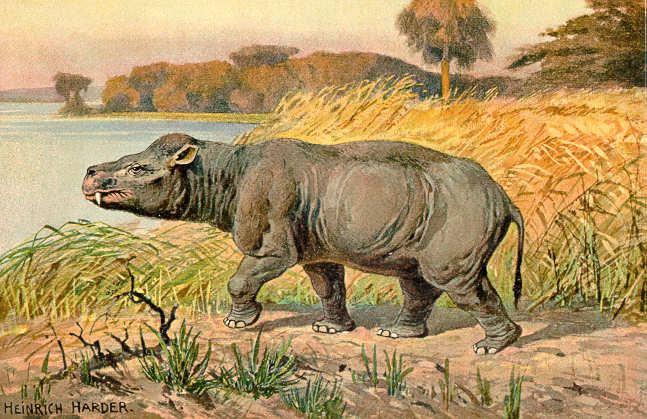 |
 |
 |
 |
 |
Produced
by the Population Genetics and Evolution class, Furman University |
||||
 |
 |
 |
 |
 |
Produced
by the Population Genetics and Evolution class, Furman University |
||||
 |
The
Paleogene: Coryphodon and the Pantodonts |
 |
||
| Coryphodon
and the pantodonts were the first large browsing mammals to walk the face
of the Earth (Wikipedia 2010). Coryphodon was the largest pantodont
during this era, measuring one meter at the shoulder and 2.35 meters in
length (Wikipedia 2010). Coryphodon had long forelimbs and shorter
hind limbs, which were used to support its 1,100 pound weight (Wikipedia
2010). Although this mammal was large, it had one of the smallest brain
to body ratios, with its brain only weighing around 3.2 ounces (Wikipedia
2010). Coryphodon had a very strong neck and was equipped with
tucks that were most likely used when foraging for food in warm swamp
forests (Wikipedia 2010). Coryphodon, as well as all pantodonts,
had upper third and fourth premolar tooth crowns, which had v-shaped crests,
and had broad lower premolars and molars, indicating that plants were
the sole source of nutrients for these mammals (Lucas 2010). It is likely
that Coryphodon was amphibious like today’s hippo, and
ranged across North America and Asia (Jehle 2006). Typically, pantodonts
from Asia were smaller than those of North America (Jehle 2006). Like
most large pantodonts, Coryphodon had a diverse diet of plants
depending on the season, ranging from flowers and leaves to pine needles
and fungi (Wikipedia 2010). The extinction of Coryphodon marked
the end of the pantodonts in North America and Europe; however, other
species of pantodonts in Asia survived into the middle Eocene when they
were replaced by prehistoric tapirs and rhinos (Lucas 2010).
Page by Chapin Hardy |
 |
| Coryphodon. Picture From: Wikipedia | |
|
Jehle M. 2006. Paleocene mammals of the world. Accessed April 12, 2010. Lucas SG. 2010. Pantodonta. AccessScience. Accessed April 12, 2010 Wikipedia. 2010. Coryphodon. Accessed April 12, 2010. |